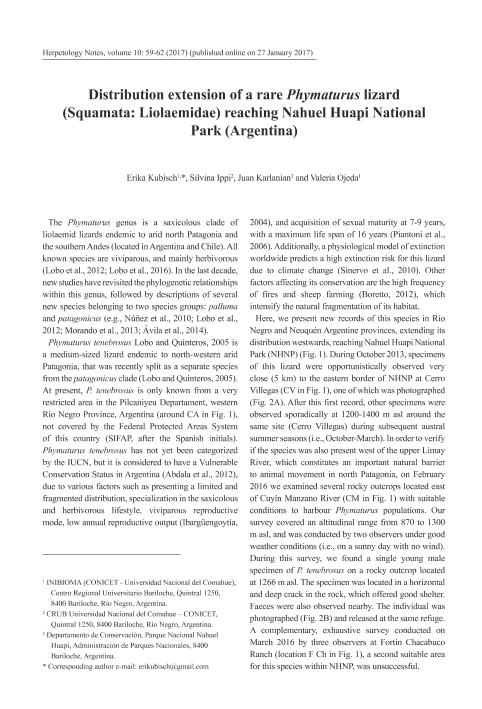Artículo
Distribution extension of a rare Phymaturus lizard (Squamata: Liolaemidae) reaching Nahuel Huapi National Park (Argentina)
Fecha de publicación:
01/2017
Editorial:
Societas Europaea Herpetologica
Revista:
Herpetology Notes
ISSN:
2071-5773
Idioma:
Inglés
Tipo de recurso:
Artículo publicado
Clasificación temática:
Resumen
The Phymaturus lizards from arid South America are Vulnerable because of restricted distributions of most species (not overlapping protected areas), life history attributes (e.g., viviparity), and taxonomic redefinitions that obstruct conservation assessments. Among the new species is P. tenebrosus, endemic to a small area in northwestern Argentine Patagonia where a century of sheep farming intensified the natural fragmentation of its habitat: rocky outcrops. We recorded P. tenebrosus in the ecotone between Andean forests and arid steppe, west of previous documented sites. Our sightings were on both sides of the Limay River, hence, within the Nahuel Huapi National Park. Although the Park is under conservation measures, the area where P. tenebrosus was found is heavily impacted by livestock. Therefore, we encourage studies on these reptiles east and west of the Limay River (for population divergences are expectable due to such a natural barrier), and long-term monitoring within the national park.
Palabras clave:
Phymaturus
,
Nahuel Huapi National Park
,
New Records
Archivos asociados
Licencia
Identificadores
Colecciones
Articulos(CCT - PATAGONIA NORTE)
Articulos de CTRO.CIENTIFICO TECNOL.CONICET - PATAGONIA NORTE
Articulos de CTRO.CIENTIFICO TECNOL.CONICET - PATAGONIA NORTE
Articulos(INIBIOMA)
Articulos de INST. DE INVEST.EN BIODIVERSIDAD Y MEDIOAMBIENTE
Articulos de INST. DE INVEST.EN BIODIVERSIDAD Y MEDIOAMBIENTE
Citación
Kubisch, Erika Leticia; Ippi, Silvina Graciela; Karlanian, Juan; Ojeda, Valeria Susana; Distribution extension of a rare Phymaturus lizard (Squamata: Liolaemidae) reaching Nahuel Huapi National Park (Argentina); Societas Europaea Herpetologica; Herpetology Notes; 10; 2017; 1-2017; 59-62
Compartir




